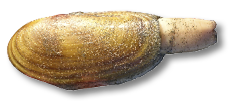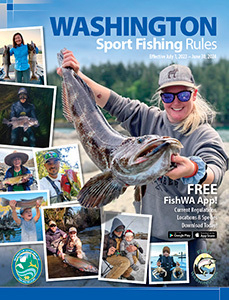Razor Clam Rules
Area |
Species |
Season |
Additional Rules |
Razor Clams (Siliqua Patula) |
|||
Grows to 6"; fragile, thin elongated shells are covered with shiny, tan lacquer-like skin coating the shell. Found only on Pacific coastal beaches. Razor clam seasons occur only after clam samples have been tested for marine biotoxins by Washington Department of Health (DOH) and are found to be safe for human consumption. |
|||
Coastal Beaches |
Razor Clams |
To Be Announced |
No min. size. Daily limit first 15 dug regardless of size or condition (broken clams count towards limit). Each limit must be in a separate container. |
- May only be taken by hand, hand-operated shovel, or tube with a minimum outside diameter of 4" (4" x 3" if elliptical).
- All clams dug are part of digger’s limit - you may not return any razor clams to the beach or water.
- It is illegal to drive any vehicle or to lead or ride a horse on razor clam beds (westerly of a line 150' waterward of the extreme upper limit of the hard sand area). Pressure from weight of vehicles and digging action of horses’ hooves cause clam mortality.
- The person with a disability for whom razor clams are being dug must be in line of sight of the designated harvester or within ¼ mile of the digging site. Both the digger and the person with a disability must be licensed. The person with a disability must have a designated harvester companion card. The designated harvester must have the designated harvester companion card in their possession while assisting the person with a disability. (See License Information).
Ocean Razor Clam Beach Descriptions
Long Beach: Columbia River north jetty to Leadbetter Point (includes Seaview, Cranberry, Klipsan, Ocean Park, and Oysterville).
Twin Harbors: Northern shore of Willapa Bay (from Toke Point west, not including the beaches within the Shoalwater Bay Indian Reservation) to the Grays Harbor south jetty (includes North Cove, Grayland, and Westport).
Copalis: Grays Harbor north jetty to the Copalis River (includes Ocean Shores, Oyhut, Ocean City, and Copalis).
Mocrocks: Copalis River to the southern boundary of the Quinault Indian Nation (includes Iron Springs, Roosevelt, Pacific Beach, and Moclips).
Kalaloch: Olympic National Park South Beach Campground to Brown's Point (just south of Olympic National Park Beach Trail #3).
Permanent Razor Clam Reserve Closures (Areas Marked With Posts And Signs)
Razor clam sanctuaries (Reserves) are ¼ mile sections of coastal ocean beaches located on three beach areas that are used to assist in the management of the razor clam resource. The three areas are marked with metal posts and are signed to designate a "no digging" area. The three areas are:
Copalis Beach — from a point 0.4 miles south of the Ocean City approach (2nd Ave.) and extending south for ¼ mile.
Twin Harbors Reserve — from the middle of the County Line Rd. approach south for ¼ mile.
Long Beach Reserve — beginning 2.7 miles north of the Oysterville approach and extending north for ¼ mile.

Pacific Razor Clam (Siliqua patula)
Grows to 6"; fragile, thin elongated shells are covered with shiny, tan lacquer-like skin coating the shell. Found only on Pacific coastal beaches.


